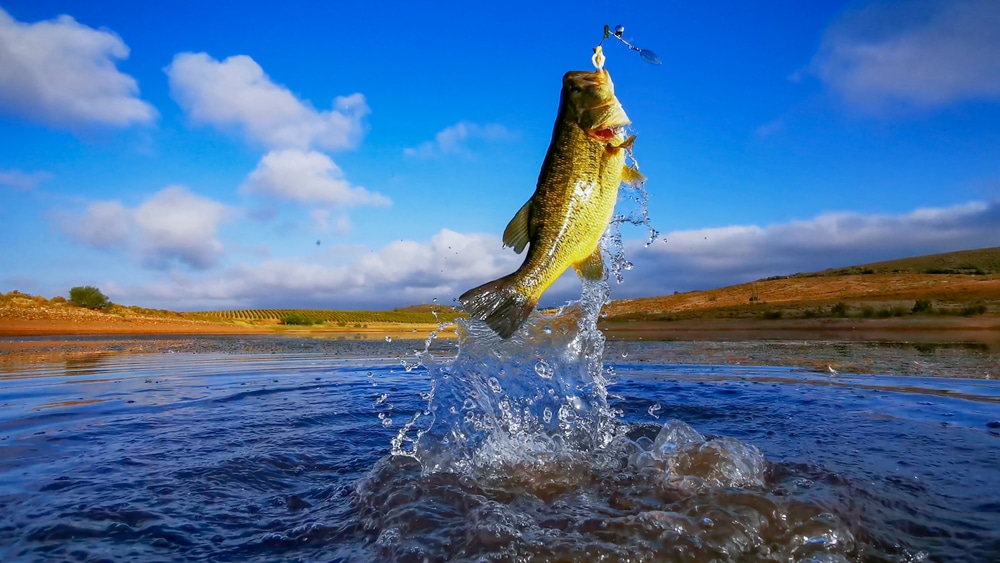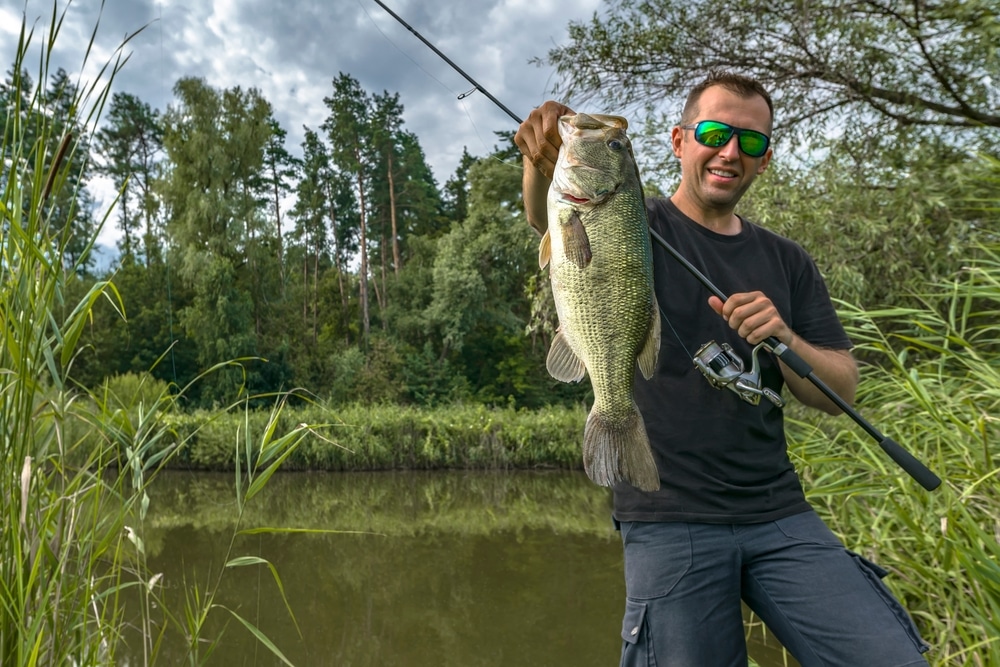Jerkbaits are a very popular lure for fish, including smallmouth and largemouth bass.
If you are new to fishing, you have probably heard the term Jerkbaits and wondered what they are.
They are minnow-shaped plastic lures that have an ingenious design.
When they are pulled through the water by your fishing line, Jerkbaits swim in a fish-like manner, but when you jig them or use the flick-pause method, they begin to swim erratically.
That erratic movement draws in predatory fish for an easy hook-set. That is one of the best reasons why Jerkbaits are so popular.

Contents
Jerkbaits Fishing Rod Setup for Bass Guide
Fishing Rods
The idea Jerkbaits setup is a 7′-7 1/2′ casting rod.
Why a casting rod for bass? When fishing Jerkbaits, you do a lot of casting out, reeling in, and then casting out again.
The length is somewhat up to you, but 7-foot rods give you enough length to adjust the line in the water and also to move the Jerkbaits appropriately.
The power rating of the rod is best in the medium range though medium-light power is good.
You want the rod to be stiff enough to support larger fish while still enabling you to feel bites. Medium-light does that.
You can opt for medium or medium-light power ratings.
The action rating should be fast or light. Some anglers prefer ultra-light, but light action is perfect.
The action tells us where the rod blank will bend.
For Jerkbaits, you want the rod blank to bend only at the tip, which helps the rod recover from the short jig motion that you use with Jerkbaits.
A spinning reel is ideal with a gear ratio that is 6.3:1.
That is very important because you need the reel to also be fast at the uptake so that you can set the hook quickly rather than miss hook-set opportunities because you are reeling in line.
For the Rod Handle, you want it shorter and more comfortable.
You will be using it a lot throughout the day.
The shorter handle, such as with a split grip, allows you to easily flick the rock to activate the Jerkbaits.
The line choice is going to be more mono or fluorocarbon for Bass – smallmouth or largemouth.
They have keen eyesight, and these options for lines are the most invisible in the water.
Many anglers use braided lines with a longer leader of mono or fluorocarbon.
Braided is okay if you are using Jerkbaits offshore or from shore where larger fish may lurk.
Redfish, snook, and bonefish are big enough to warrant braided line.
The best knots are the Palomar knot, double Uni knot, and the Improved Clinch knot.
You may use these or not, but they are worth committing how to tie them to memory.

Tips and advice
Jerkbaits Depth Adjustment – To easily raise or lower the Jerkbaits in the water column, raise or lower the tip of your fishing pole. The line angle of your fishing line as it enters the water regulates wherein the water column the lure sits. Changing the line angle as it enters the water changes the position of the Jerkbaits.
Speed of Jerkbaits Movement – You are 100 percent in control of how fast the Jerkbaits move through the water. Whether you are reeling in the line in a straight-line fashion to mimic a swimming, healthy minnow or if you are using the jig-flick and pause – method to indicate a minnow that is injured, you control the speed in which the Jerkbaits move. Finding the correct speed requires a bit of trial and error. Every fishing environment will have a different speed that works well.
Types of Jerkbaits – There are two kinds of Jerkbaits in many styles. Those are hard or soft Jerkbaits. Use hard Jerkbaits (for the most part) when the water is cold. Minnow often bask near the surface where the water temperature is warmest. Bass and other types of game fish are very sensitive to water temperature. Bass are also slow in cold water.
Use softer Jerkbaits when the water is warmer, and the fish are deeper. Softer Jerkbaits sink, whereas harder Jerkbaits are more buoyant.
Location or environmental differences?
The key to water conditions is colder water, clear to tea-stained color, and where the water is shallow.
These are ideal for spring run-off before the turbidity in the water makes the water cloudy.
Bass often spawn in late spring or late winter.
The water is cold and often shallow.
Male bass are left behind to tend the eggs and guard them. You can pull a male bass off his egg pile with Jerkbaits.
Soft Jerkbaits setup
The only thing you need to know about setting up soft Jerkbaits is that you will need to thread the Jerkbaits onto your hook.
Some anglers may pop the hook laterally through the head, but that will affect how the Jerkbaits swim.
Remember that Jerkbaits are designed for swimming like a minnow.
Changing how you thread the hook will affect how the lure reacts when you pull it through the water column.
Can you throw topwater on a Jerkbaits setup?
Yes, you would use hard Jerkbaits since they offer more buoyancy.
You can temp big Northern Pike if you drag your Jerkbaits over the top of weedy patches or next to them.
If you are fishing in Walleye territory, you can often find Northern Pike or Walleye in weed patches.
Jerkbaits fishing is one of the top methods for targeting bass.
The unique structure of Jerkbaits brings out the predatory habits of fish.
While Jerkbaits are keen on bass fishing, they also work well on different species of fish in fresh or saltwater.
Getting started fishing with Jerkbaits is fun, and it does not have to be overly expensive.
Because of the unique nature of Jerkbaits and the specifics for rods and reels, you might consider setting up a dedicated Jerkbaits fishing pole.
Be sure to also start a collection of Jerkbaits, both hard and soft ones, in various colors. Bass and other predatory fish will go for one color or another as the seasons change.







